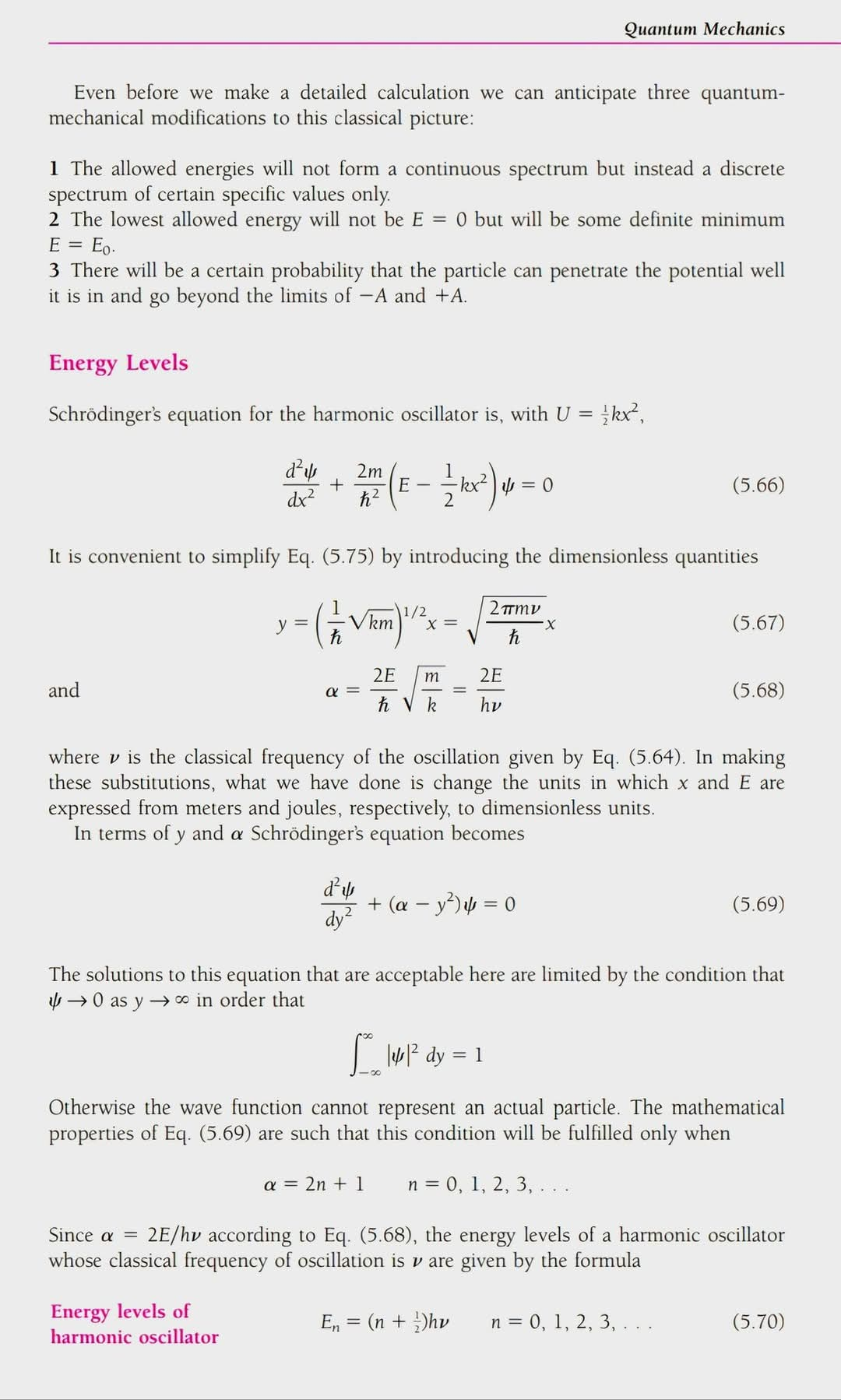양자 역학의 기본적인 개념 이해
Understanding the basic concepts of quantum mechanics
이 이미지는 양자 역학(Quantum Mechanics)에서 단순 조화 진동자(Simple Harmonic Oscillator)의 에너지 준위(Energy Levels)를 계산하는 과정을 보여줍니다. 고전적인 단순 조화 진동자와는 달리, 양자 역학에서는 에너지가 연속적인 값이 아니라 특정한 이산적인 값(discrete values)만 가질 수 있다는 점이 중요합니다.
핵심 내용:
1. 고전적인 그림과의 차이점: 이미지는 먼저 고전적인 단순 조화 진동자 모델과 양자 역학적인 모델 사이의 세 가지 주요 차이점을 언급합니다.
- 에너지는 연속적인 스펙트럼이 아니라 이산적인 스펙트럼을 가집니다.
- 가장 낮은 허용 에너지 준위는 0이 아니라 어떤 최소값(E₀)을 가집니다. (영점 에너지: zero-point energy)
- 입자가 퍼텐셜 우물(potential well)을 뚫고 나갈 확률이 존재합니다. (터널링 효과: tunneling effect)
2. 슈뢰딩거 방정식: 단순 조화 진동자에 대한 슈뢰딩거 방정식(Schrödinger's equation)이 제시됩니다. 이 방정식은 진동자의 파동 함수(wave function) ψ를 구하기 위한 기본 방정식입니다.
3. 무차원화: 방정식을 풀기 위해 무차원 변수(dimensionless quantities) y 와 α 를 도입하여 슈뢰딩거 방정식을 단순화합니다.
4. 허용 가능한 해: 허용 가능한 해는 파동 함수가 무한대로 갈 때 0으로 수렴해야 하며, 전체 공간에 대한 파동 함수의 제곱의 적분이 1이 되어야 합니다. ( ∫ψ² dy = 1 ) 이 조건을 만족하는 해는 α = 2n + 1 (n = 0, 1, 2, ...)일 때만 존재합니다.
5. 에너지 준위: α 와 에너지 E 의 관계를 이용하여, 단순 조화 진동자의 에너지 준위 Eₙ 이 다음 공식으로 주어짐을 보여줍니다.
plaintext
Eₙ = (n + 1/2)ħν n = 0, 1, 2, 3, ...
여기서:
- n 은 양자수(quantum number)
- ħ 는 환산 플랑크 상수(reduced Planck constant)
- ν 는 고전적인 진동수(classical frequency)
결론:
이미지는 양자 역학적 단순 조화 진동자의 에너지 준위가 이산적이며, 고전적인 경우와는 달리 영점 에너지를 가짐을 보여주는 수학적인 유도 과정을 제시합니다. 이것은 양자 역학의 기본적인 개념을 이해하는 데 중요한 부분입니다.

The image shows a section from a quantum mechanics textbook that explains the calculation of energy levels for a simple harmonic oscillator. It highlights the key difference between the classical and quantum mechanical models of the simple harmonic oscillator, where energy is quantized in the latter.
Key Points:
1. Differences from the Classical Picture: The image first outlines three key differences between the classical and quantum models of the simple harmonic oscillator.
- Energies are quantized, forming a discrete spectrum rather than a continuous one.
- The lowest allowed energy level is not zero but a finite minimum value (E₀), known as the zero-point energy.
- There's a probability for the particle to penetrate the potential well and go beyond the limits of -A and +A (tunneling effect).
2. Schrödinger's Equation: The Schrödinger equation for the simple harmonic oscillator is presented, which is the fundamental equation for determining the wave function ψ of the oscillator.
3. Dimensionless Variables: To simplify the equation, dimensionless variables y and α are introduced.
4. Acceptable Solutions: Acceptable solutions to the Schrödinger equation are limited by the condition that the wave function ψ approaches zero as y approaches infinity, and the integral of the squared wave function over all space equals one (∫ψ² dy = 1). These conditions are only fulfilled when α = 2n + 1 (n = 0, 1, 2, ...).
5. Energy Levels: Using the relationship between α and energy E, the energy levels Eₙ of the simple harmonic oscillator are given by the formula:
plaintext
Eₙ = (n + 1/2)ħν n = 0, 1, 2, 3, ...
where:
- n is the quantum number
- ħ is the reduced Planck constant
- ν is the classical frequency
Conclusion:
The image demonstrates the mathematical derivation of the quantized energy levels of a simple harmonic oscillator in quantum mechanics, highlighting the key difference from the classical model. It emphasizes the concept of zero-point energy and provides a fundamental understanding of quantum mechanics.